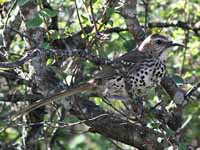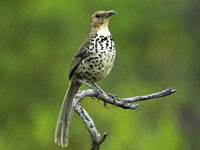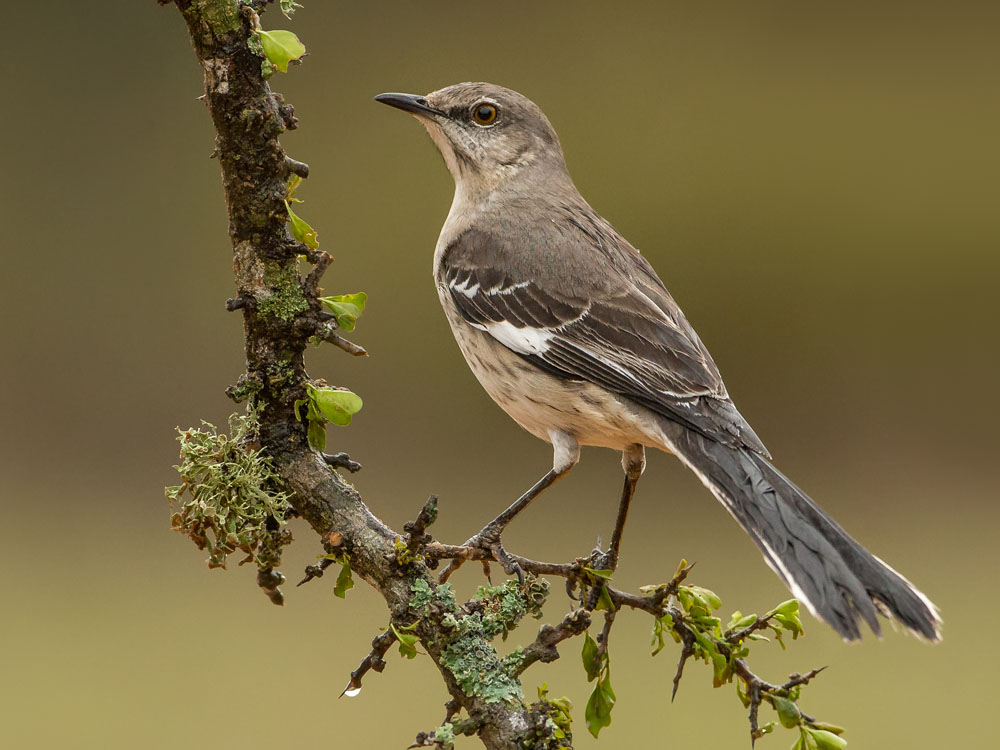THE WORLD BIRDS - An Online Bird Book
Order Passeriformes Family Mimidae
Mimics - Mockingbirds and Allies
Order Passeriformes Family Mimidae
Of the 34 members of family Mimidae, about one third are mimics of the songs of other bird species. The family members are the catbirds, mockingbirds, thrashers, and tremlbers. Many mimids have a rather thrush-like pattern: brown above, pale with dark streaks or spots below. They tend to have longer tails than thrushes. They have long, strong legs with which enable many species to hop through undergrowth searching for food. The mimids are found in the Americas including the Caribbean.
Catbirds are so named because their calls can sometimes resemble that of a cat. Mockingbirds are so named because a few (about a third) of the species are excellent mimics, which is the case for the most widespread and famous one - the northern mockingbird. The name thrasher refers to the foraging technique on the ground of moving the head and its relatively long bill from sided to side, especially among leaf litter. About 1/3 of the thrashers are also mimics. The tremblers flutter their wings very often, which can also give a tremblng sound to their voice.
The mimids mainly eat insects and other arthropods, fruits, and berries. The arthropods are usually found on the ground and the the fruits and berries low in the trees. They construct cup-shaped nests which are made out of sticks and lined with softer material. The nests are placed low in trees, bushes, cactus, and very infrequently on the ground.
Genus Allenia - 1 species
Thrasher,_Scaly-breasted Allenia fusca
Description: The scaly-breasted thrasher has dark grey-brown upperparts and head. The rump has a reddish tinge, there are thin white wing-bars, and the eyes are yellow. The short dark bill has a slight downward curve. It has pale underparts with grey-brown scalloping, The scaly-breasted thrasher is about 23 cm long.
Range: Lesser Antilles of the Caribbean.
Habitat: Forests, woodlands, trees in towns.
Diet: Insects, spiders, fruits, and berries. Mainly forages in trees.
Conservation status: Least Concern.
Range: Lesser Antilles of the Caribbean.
Habitat: Forests, woodlands, trees in towns.
Diet: Insects, spiders, fruits, and berries. Mainly forages in trees.
Conservation status: Least Concern.
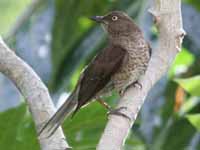
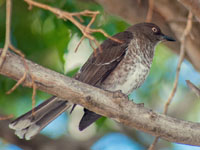
Genus Cinclocerthia
When excited, the tremblers flick their wings and their entire bodies in a trembling motion. The trembling results in reverberation when singing. They do not mimic bird songs.
Trembler,_Brown Cinclocerthia ruficauda
Description: The brown trembler has an olive-brown back plus a rufous-brown rump and tail. It has a greyish-brown crown, blackish face, yellow eyes, and a blackish down-curved bill. The throat is greyish buff and underparts are greyish-brown with cinnamon flanks. The brown trembler is 20 to 26 cm long.
Range: Lesser Antilles of the Caribbean.
Habitat: Humid evergreen forest; also secondary forest and plantations.
Diet: Fruits, insects, spiders, small vertebrates. Forage in trees and also on the ground.
Conservation status: Least Concern.
Range: Lesser Antilles of the Caribbean.
Habitat: Humid evergreen forest; also secondary forest and plantations.
Diet: Fruits, insects, spiders, small vertebrates. Forage in trees and also on the ground.
Conservation status: Least Concern.
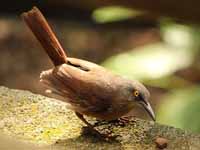

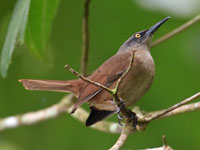
Trembler, Grey Cinclocerthia gutturalis
Description: The grey trembler has grey-brown upperparts with darker wing, a black mask, and yellow eyes. The grey trembler is 23 to 26 cm long.
Range: Martinique, Saint Lucia.
Habitat: Mature forests, woodlands, scrub.
Diet: Insects, other invertebrates, fruits.
Conservation status: Least Concern.
Image by: 1) Joseph Smit 2) Marcel HolyoakRange: Martinique, Saint Lucia.
Habitat: Mature forests, woodlands, scrub.
Diet: Insects, other invertebrates, fruits.
Conservation status: Least Concern.
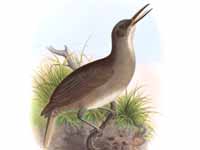
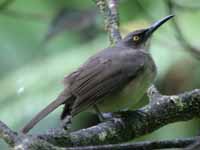
Genus Dumetella - 1 species
Catbird,_Grey Dumetella carolinensis
Description: The grey catbird has mainly lead-grey plumage, a darker cap, black eyes, a black bill, and rust colored under-tail coverts. The grey catbird is named for its cat-like call. It also mimics other bird songs plus tree frogs and even mechanical sounds. That said, it does not have the repertoire of a mockingbird, does not repeat a particular song, and sings hidden in brush, not out in the open. The bulky nest is located in a bush or low in a tree. They destroy eggs that the brown-headed cowbird lay in its nest. The grey catbird is 20 to 24 cm long.
Range: North America east of the Rockies, Central America.
Habitat: Dense thorny or bushy habits.
Diet: Fruits and berries. Also insects, worms.
Conservation status: Least Concern.
Range: North America east of the Rockies, Central America.
Habitat: Dense thorny or bushy habits.
Diet: Fruits and berries. Also insects, worms.
Conservation status: Least Concern.
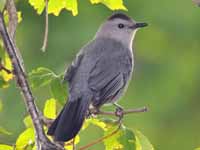
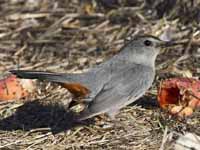
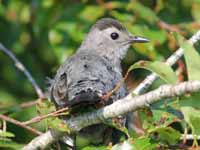
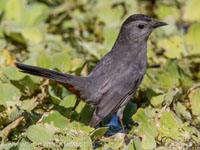
Genus Margarops - 1 species
Thrasher,_Pearly-eyed Margarops fuscatus
Description: The pearly-eyed thrasher has brown upperparts. The underparts have a brown and white wavy patterns. It has pale eyes. It is very aggressive to competitor species. The pearly-eyed thrasher averages about 26 cm long, but its length is quite variable. It sings often, especially during breeding season. The songs are rather monotone while still being varied. They are not known to mimic other species. This thrasher will usually place its cup-shaped nest in a tree or bush, but also uses cavities in trees, under bridges, etc.
Range: Puerto Rico, Virgin Islands, and neighborhood.
Habitat: A wide range of habits, choosing places that are underutilized by other birds.
Diet: An opportunistic omnivore that eats what is available: insects, fruits, lizards, frogs, eggs, chicks.
Conservation status: Least Concern.
Image by: 1, 2) Dick Daniels - Puerto Rico 3, 4) Dick - St John island, Virgin Islands Range: Puerto Rico, Virgin Islands, and neighborhood.
Habitat: A wide range of habits, choosing places that are underutilized by other birds.
Diet: An opportunistic omnivore that eats what is available: insects, fruits, lizards, frogs, eggs, chicks.
Conservation status: Least Concern.
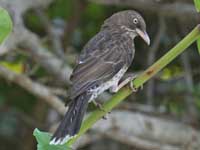
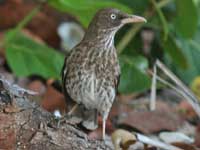

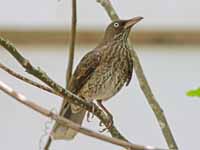
Genus Melanoptila - 1 species
Catbird_ Black Melanoptila glabrirostris
Description: The black catbird has glossy black plumage, black bill, and black legs. The eyes are dark reddish. It does not mimic other species. The black catbird is about 20 cm long.
Range: Yucatan Peninsular of eastern Mexico, Belize, Guatemala.
Habitat: Woodlands, scrublands.
Diet: Probably an omnivore eating fruits and arthropods.
Conservation status: It is listed as Near Threatened because if it is found in a small range and its population is decreasing, perhaps rapdily.
Image by: 1) Amy McAndrews 2) dfaulderRange: Yucatan Peninsular of eastern Mexico, Belize, Guatemala.
Habitat: Woodlands, scrublands.
Diet: Probably an omnivore eating fruits and arthropods.
Conservation status: It is listed as Near Threatened because if it is found in a small range and its population is decreasing, perhaps rapdily.
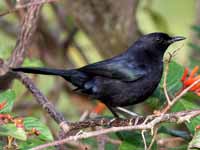
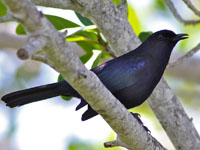
Genus Melanotis
Mockingbird, Blue Melanotis caerulescens
Description: The blue mockingbird has mainly dark blue plumage, with a dark mask across the face. The breast has dark streaks; the bill is black as are the legs. It has a long graduated tail which adds to its length. The blue mockingbird is up to 27 cm long. It has various songs, but not known to mimic other bird species.
Range: Mexico.
Habitat: Dense thickets and thus hard to observe.
Diet: Fruits, insects.
Conservation status: Least Concern.
Image by: 1) Martin_Marquez 2, 3) Pablo LeautaudRange: Mexico.
Habitat: Dense thickets and thus hard to observe.
Diet: Fruits, insects.
Conservation status: Least Concern.
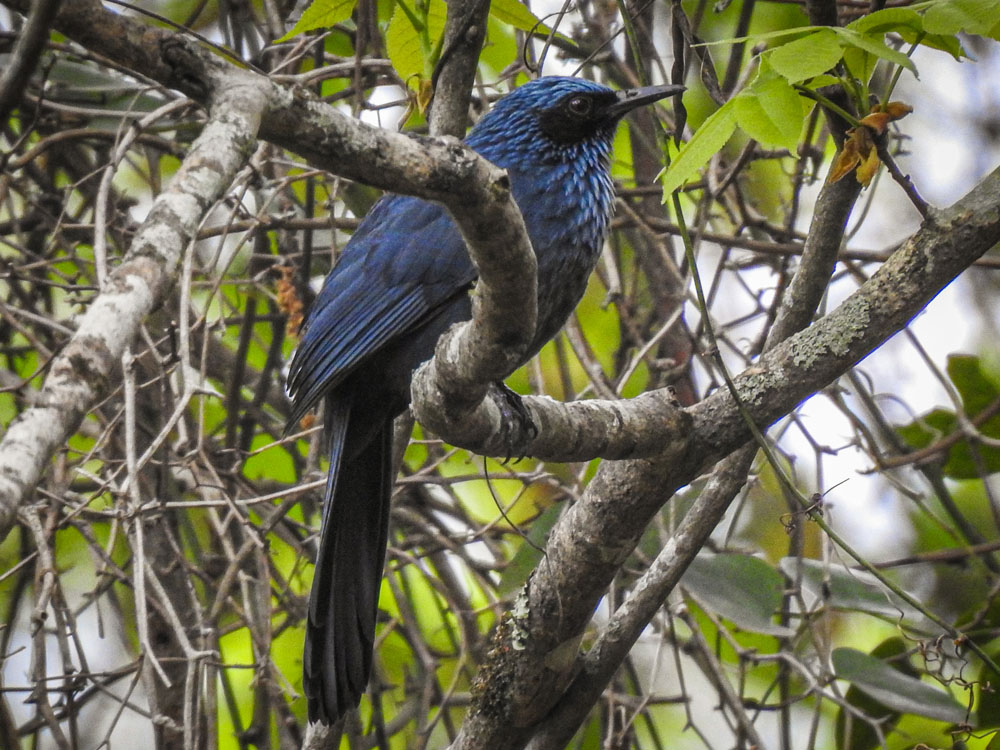
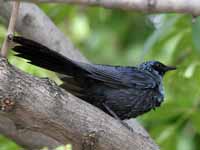
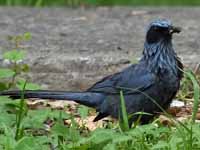
Mockingbird,_Blue-and-White Melanotis hypoleucus
Description: The blue-and-white mockingbird has greyish-blue upperparts, a black mask, white underparts, and red eyes. The wings are darker, as is the tail - especially on its underside. The blue-and-white mockingbird is 24 to 28 cm long. Its song, consisting of a mixture of sounds, is repeated 2 to 3 times. The blue mockingbird is its closest relative.
Range: El Salvador, Guatemala, Honduras, Mexico.
Habitat: Forests, woodlands, scrubland.
Diet: Arthropods; also fruits. It forages on the ground.
Conservation status: Least Concern.
Image by: 1) Amy McAndrews - Chiapas, Mexico 2) - Mexico 3) Grete_Pasch - GuatemalaRange: El Salvador, Guatemala, Honduras, Mexico.
Habitat: Forests, woodlands, scrubland.
Diet: Arthropods; also fruits. It forages on the ground.
Conservation status: Least Concern.
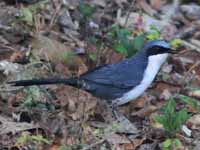
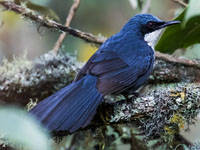
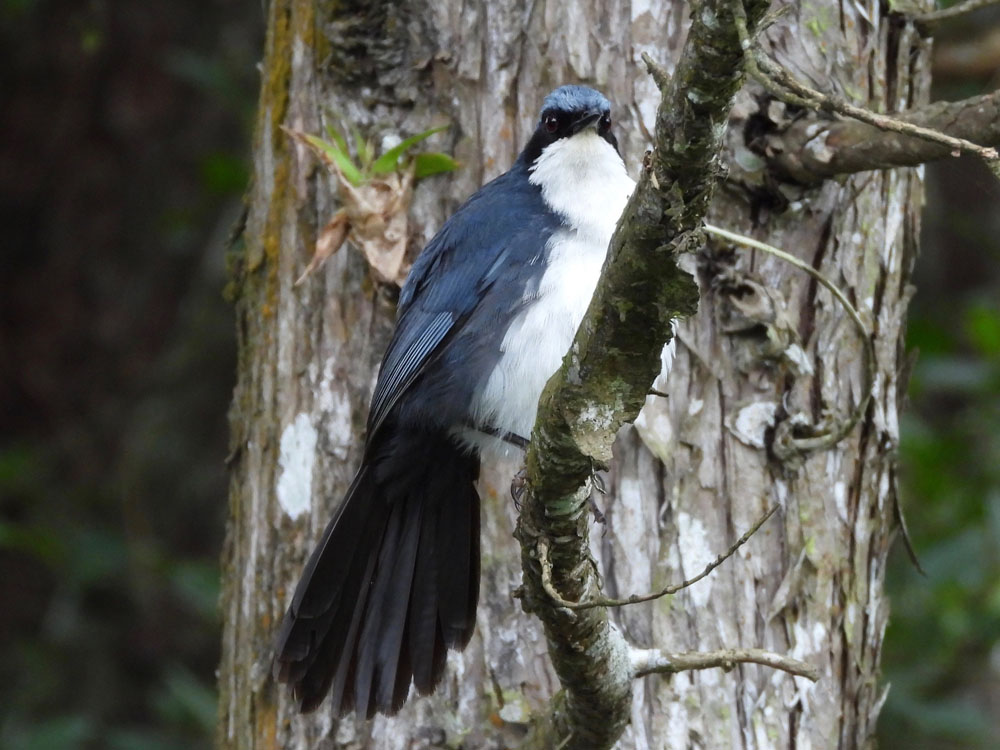
Genus Mimus
This genus contains the typical mockingbirds for which the family Mimidae is named. The name is Latin for mimic.
Mockingbird,_Bahama Mimus gundlachii
Description: The Bahama mockingbird has brownish-grey upperparts. The mottled head and neck are paler plus there are faint dark streaks along the nape and mantle. It has a faint eye-line, dark lores and a white arc above and below the eyes. The underparts are pale with some streaking on the breast and darker on the flanks. The Bahama mockingbird is 28 cm long. It has various songs which are repeated, but not known to mimic other species. The cup-like nest is usually located low on a bush, but it might also be on the ground The similar northern mockingbird back is grey and unstreaked. Where their ranges overlap, the Bahama mockingbird favors taller and denser woodlands.
Range: Bahamas, Cuba, Jamaica, Turks and Caicos Islands.
Habitat: Varied from sandy beaches to woodlands.
Diet: Invertebrates, nectar, small fruits, and small lizards. Prefers to forage on ground; also in trees.
Conservation status: Least Concern.
Image by: 1, 2) Laura Gooch - Cuba 3) Dan Irizarry 4) Len_WorthingtonRange: Bahamas, Cuba, Jamaica, Turks and Caicos Islands.
Habitat: Varied from sandy beaches to woodlands.
Diet: Invertebrates, nectar, small fruits, and small lizards. Prefers to forage on ground; also in trees.
Conservation status: Least Concern.
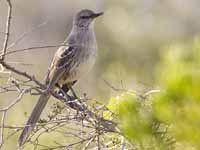
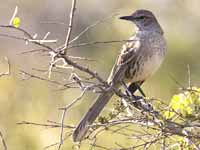
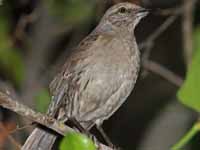
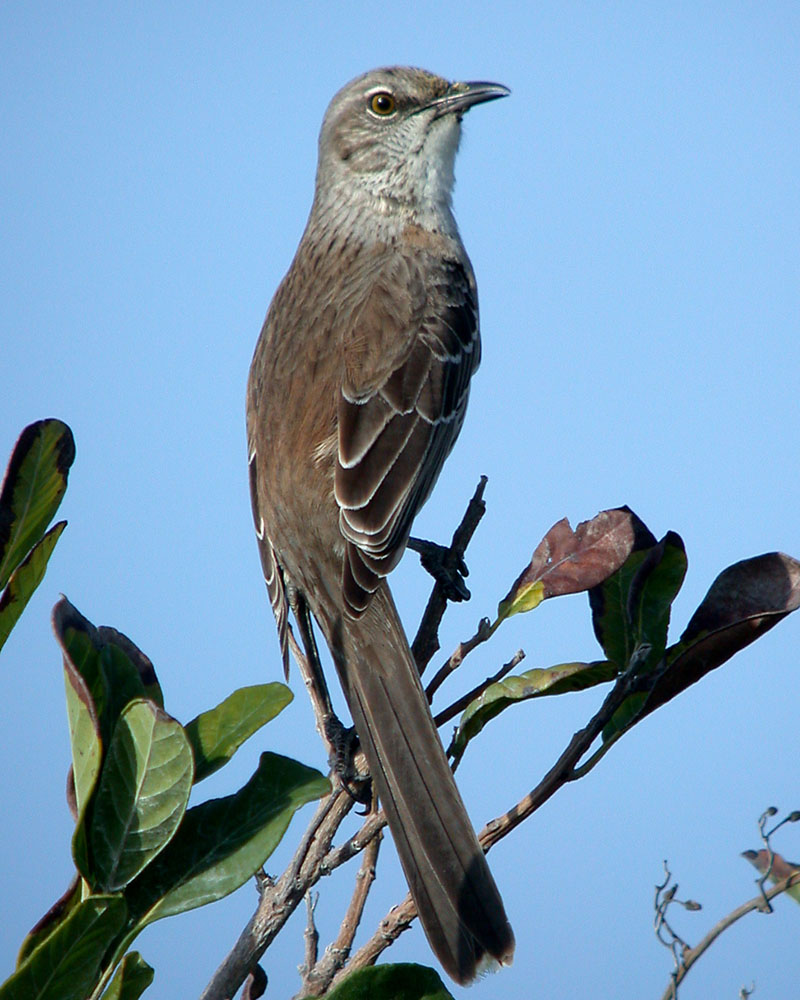
Mockingbird,_Brown-backed Mimus dorsalis
Description: The brown-backed mockingbird has a brown back and rump with an upper-tai that is mostly dark (it has white on the outer-tail). It has a black eye-line, white supercilium, and the crown has darker streaks. The underparts are whitish with a buff tinge to the breast and flanks. The twig comprised cup-shaped nest is often in a cactus and sometimes scrubs. It is not known for being a mimic. The brown-backed mockingbird is 21 to 25 cm long.
Range: Mainly in Bolivia, also Argentina, Chile.
Habitat: Brush, desert scrubs, and hedgerows; often near human habitation.
Diet: Probably an omnivore. Forages on the ground.
Conservation status: Least Concern.
Image by: 1) Ron Knight - Argentina 2) - ArgentinaRange: Mainly in Bolivia, also Argentina, Chile.
Habitat: Brush, desert scrubs, and hedgerows; often near human habitation.
Diet: Probably an omnivore. Forages on the ground.
Conservation status: Least Concern.
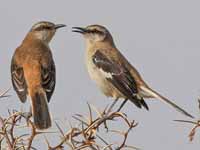

Mockingbird, Chalk-browed Mimus saturninus
Description: The chalk-browed mockingbird has brownish upperparts with darker streaks. The wings are darker than the rest of the upperparts and have some white. Similarly the dark tail has feathers with white tips and the edges are white. It has a dark brown crown with a white supercilium that is bold and wide. There is a dark eye-line. The underparts are white with the breast having a grey tinge and the flanks buffy. The chalk-browed mockingbird is 23 to 26 cm long. It has its own song and also mimics other species.
Range: Central and southwestern South America.
Habitat: Savanna, forest edge, open woodland, pastures with scattered trees, gardens.
Diet: Fruits, berries, seeds, insects, small invertebrates.
Conservation status: Least Concern.
Image by: 1) Dario Niz 2) Dario Sanches - Brasil 3) Cláudio
Timm - Brazil 4) Cristiano Crolle - Buenos Aires, ArgentinaRange: Central and southwestern South America.
Habitat: Savanna, forest edge, open woodland, pastures with scattered trees, gardens.
Diet: Fruits, berries, seeds, insects, small invertebrates.
Conservation status: Least Concern.
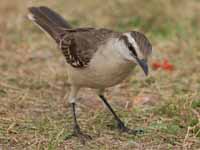
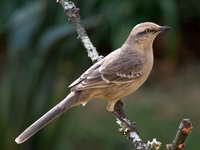
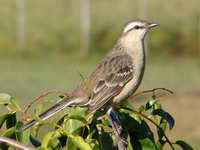
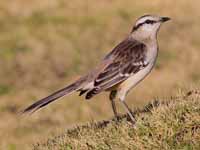
Mockingbird,_Chilean Mimus thenca
Description: The Chilean mockingbird has brown upperparts, pale underparts with some streaking on the flanks, a white supercilium, dark eye-line. and dark malar streak. Its song has phrases repeated 2 or 3 times, but it is not a mimic. The Chilean mockingbird is 28 to 29 cm long. Its nest is placed low in trees, bush, or cactus.
Range: Chile.
Habitat: Savanna, shrubland, open woodland.
Diet: Insects, fruits, nectar. Forages on the ground turning over leaf litter.
Conservation status: Least Concern.
Image by: 1) Flavio Camus 2) Pablo Contreras 3, 4) Dick DanielsRange: Chile.
Habitat: Savanna, shrubland, open woodland.
Diet: Insects, fruits, nectar. Forages on the ground turning over leaf litter.
Conservation status: Least Concern.
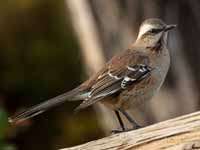


Mockingbird,_Long-tailed Mimus longicaudatus
Description: The long-tailed mockingbird has brownish-grey upperparts including the crown and the tail that has a white tip. It has a broad white supercilium, black eye-line and whitish face. The breast is light brown becoming more white towards the belly. Its long tail adds to its length which is 27 to 30 cm. It is not know to mimic other bird species. Its nest is placed low in trees, bush, or cactus.
Range: Ecuador, Peru.
Habitat: Coastal desert scrub, arid woodland, tree groves in agricultural areas.
Diet: Invertebrates (both terrestrial and marine), fruits, and berries.
Conservation status: Least Concern.
Image by: 1) Nick Athanas 1) - Peru 2, 3, 4) Dick Daniels - Lima, PeruRange: Ecuador, Peru.
Habitat: Coastal desert scrub, arid woodland, tree groves in agricultural areas.
Diet: Invertebrates (both terrestrial and marine), fruits, and berries.
Conservation status: Least Concern.




Mockingbird, Northern Mimus polyglottos
Description: The northern mockingbird has grey to brown upperparts, pale underparts, and white patches on wings that are visible in flight. The similar Bahama mockingbird has abrown striped back while the northern mockingbird has a grey unstriped back.
It can mimic the songs of hundreds of bird species. The play list keeps growning as the bird gets older. Males mimic more often as it impresses the female. She is also impressed by males that agressively defend the nest. Like that of other mimids, the nest is made of sticks. But it stands out by being lined with various and often of materials: cigarette filters, dryer lint, twine and more.
Range: Most of the USA, southern Canada, Mexico, Carribean.
Habitat:Not in thick woods, preferring open areas with grass, shrubs, and trees.
Diet: Insects, spiders, fruits, worms.
Conservation status: Least Concern.
Image by: 1, 2, 3, 4) Dick Daniels - North Carolina It can mimic the songs of hundreds of bird species. The play list keeps growning as the bird gets older. Males mimic more often as it impresses the female. She is also impressed by males that agressively defend the nest. Like that of other mimids, the nest is made of sticks. But it stands out by being lined with various and often of materials: cigarette filters, dryer lint, twine and more.
Range: Most of the USA, southern Canada, Mexico, Carribean.
Habitat:Not in thick woods, preferring open areas with grass, shrubs, and trees.
Diet: Insects, spiders, fruits, worms.
Conservation status: Least Concern.

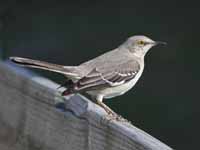

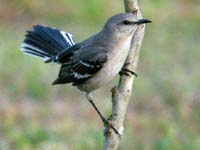
Mockingbird,_Patagonian Mimus patagonicus
Description: The Patagonia mockingbird has mainly grey plumage with darker wings and lighter underparts. It has a white supercilium. The Patagonia mockingbird is 22 to 25 cm long. It is a frequent singer of its own songs and that of other species.
Range: Mainly Argentina, also Chile.
Habitat: Shrub and bush-lands; also open woodlands.
Diet: Mainly insects, especially in the breeding season. Also fruits.
Conservation status: Least Concern.
Image by: 1) Nestor Galina 2 Charlie Westerinen - Argentina 3) Lenaldo_VigoRange: Mainly Argentina, also Chile.
Habitat: Shrub and bush-lands; also open woodlands.
Diet: Mainly insects, especially in the breeding season. Also fruits.
Conservation status: Least Concern.
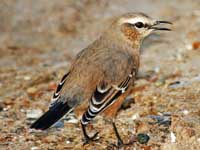
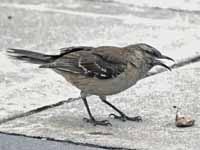
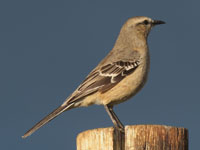
Mockingbird, Socorro Mimus graysoni
Description: The Socorro mockingbird has mainly brown plumage, a darker tail, and lighter underparts. There are two narrow white wing-bars and dark lores. It is a chunky mockingbird with a relatively short bill. The Socorro mockingbird is about 25 cm long. It has a songs that are pleasant to humans; unclear if it mimics other species.
Range: Socorro Island (Mexico).
Habitat: Open, but not degraded, woodlands.
Diet: Insects, fruits, and small vertebrates such as crags.
Conservation status: It is listed as Critically Endangered because of population declines, first due to feral sheep overgrazing, and later by feral cats. The ferals are being reduced and the birds are increasing.
Image by: 1, 2) Alan_Harper 3) Amy McAndrewsRange: Socorro Island (Mexico).
Habitat: Open, but not degraded, woodlands.
Diet: Insects, fruits, and small vertebrates such as crags.
Conservation status: It is listed as Critically Endangered because of population declines, first due to feral sheep overgrazing, and later by feral cats. The ferals are being reduced and the birds are increasing.

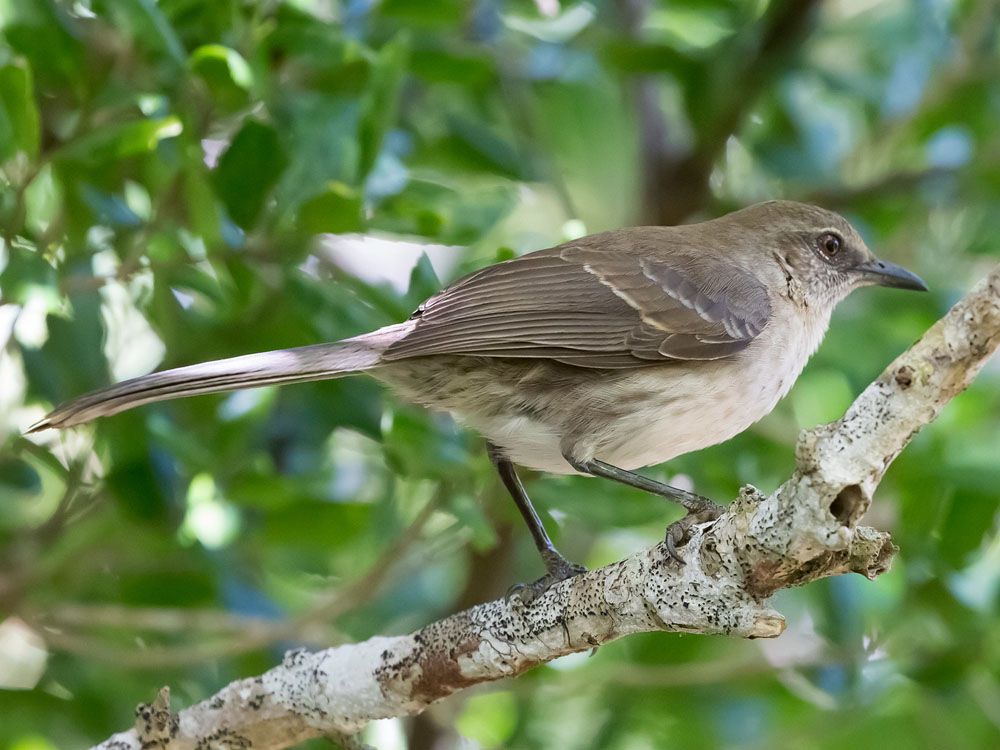
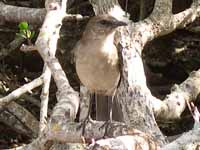
Mockingbird,_Tropical Mimus gilvus
Description: The tropical mockingbird has grey upperparts and head, yellow eyes, pale supercilium, off-white underparts, and 2 thin white wing-bars. The tropical mockingbird is 25 to 26 cm long. Its closest relative is the northern mockingbird. One major difference between them is that the tropical mockingbird is not know to mimic other species.
Range: Southern Mexico through Central America to northern and eastern South America.
Habitat: Savanna, shrubland, parks, farmland.
Diet: Insects, spiders, fruits, seeds, bird and lizard eggs.
Conservation status: Least Concern.
Image by: 1) New Jersy Birds 2) Tom
Friedel (BirdPhotos.com) - Venzuela 3) Carlos_Henrique - Ecuador 4) Amado_Demesa - Mexico Range: Southern Mexico through Central America to northern and eastern South America.
Habitat: Savanna, shrubland, parks, farmland.
Diet: Insects, spiders, fruits, seeds, bird and lizard eggs.
Conservation status: Least Concern.
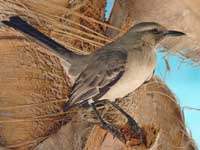
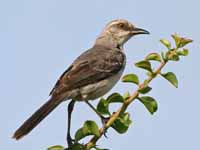
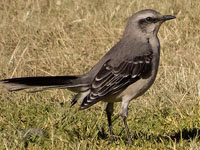
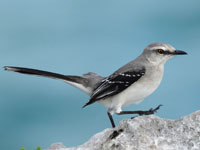
Mockingbird,_White-banded Mimus triurus
Description: The white-banded mockingbird has greyish upperparts with black wings that have a bold white band. It has a white supercilium and a dark eye-line. The outer thirds of the tail are white while the inner third is black. It has very long wings (in proportion to body). The white-banded mockingbird is 20 to 23 cm long. Its song is pleasing to humans and it can mimic other bird species. The nest is placed in shrubs, trees, or cactus.
Range: Argentina, Bolivia, Brazil, Chile, Paraguay, and Uruguay.
Habitat: Wooded lowlands, savanna, open brushy country, steppe, around human habitations.
Diet: Probably mainly insects.
Conservation status: Least Concern.
Image by: 1) elnudomolesto 2) Aldo_Giuzio - Argentina 3) Cláudio
Timm - Brazil Range: Argentina, Bolivia, Brazil, Chile, Paraguay, and Uruguay.
Habitat: Wooded lowlands, savanna, open brushy country, steppe, around human habitations.
Diet: Probably mainly insects.
Conservation status: Least Concern.
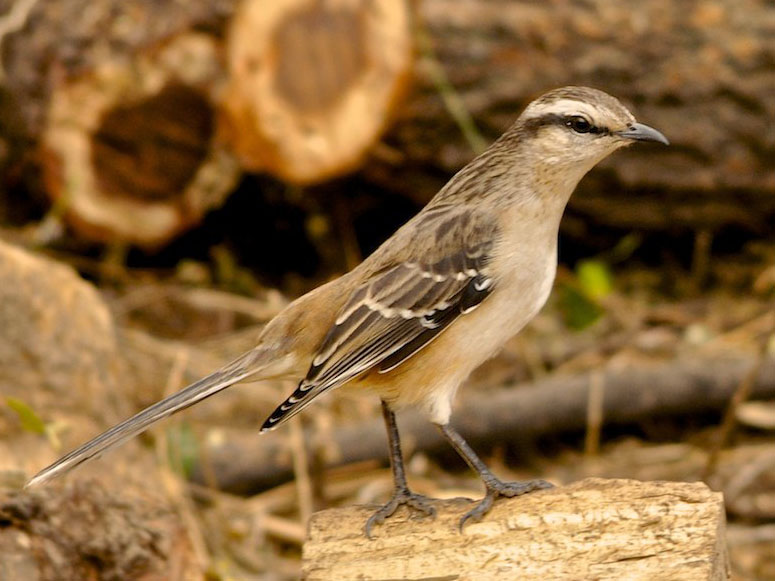
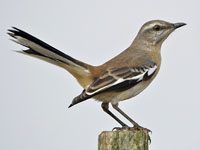
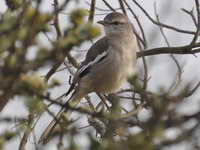
Mockingbirds of the Galapagos Islands
The remaining four mockingbird species are all found on the Galapagos Islands. The Galapagos mockingbird is by far the most widespread. The Florena Mocking bird is found near Floreana Island; Espanola mockingbird is the only mocking bird on San Cristobal island; the Floreana mocking bird is found near Floreana Island.
Mockingbird,_Floreana Mimus trifasciatus
Description:The Floreana mockingbird has greyish-brown upperparts with some darker streaks. The crown and tail are also greyish-brown. It has a pale supercilium, white face, and black lores. The underparts are mainly whitish with considerable brown on the upper-breast. It does not mimic other birds. The Floreana mockingbird is 25 to 26 cm long. The nest is usually placed in a cactus, sometimes a shrub.
Range: Near Floreana Island (Galapagos). The Floreana mockingbird is no longer found on Floreana due to cats and dogs.
Habitat: Their small islands have low vegetations, scrub, some cacti, and a few trees.
Diet: Insects. Also cactus fruit, carrion.
Conservation status: It is listed as Endangered because the population is only 250. It seems to be stable, but weather events in the past have decimated the birds.
Image by: 1) John Gould 2) Andy_KraemerRange: Near Floreana Island (Galapagos). The Floreana mockingbird is no longer found on Floreana due to cats and dogs.
Habitat: Their small islands have low vegetations, scrub, some cacti, and a few trees.
Diet: Insects. Also cactus fruit, carrion.
Conservation status: It is listed as Endangered because the population is only 250. It seems to be stable, but weather events in the past have decimated the birds.
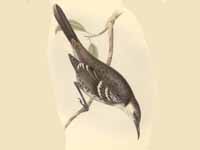

Mockingbird, Galápagos Mimus parvulus
Description: The Galapagos mockingbird is the only mockingbird that is found on more than one Galapagos island. It has greyish-brown upperparts with the wings edged in white. The crown is blackish-brown, the face is black, and there is a white streak behind the eyes. It has white underparts with some brown on the flanks. The Galapagos mockingbird is about 25 cm long. It does not mimic other species. The nest is place in a tree, cactus, or shrub.
Range: Most of the Galapagos Islands.
Habitat: Wherever food available.
Diet: Ominvore - because of their small range they cannot afford to be fussy eaters. They eat seeds, fruits, invertebrates, eggs, baby turtles.
Conservation status: Least Concern.
Image by: 1, 2, 3)
Dick Daniels - Galapagos Islands 4) Mark PutneyRange: Most of the Galapagos Islands.
Habitat: Wherever food available.
Diet: Ominvore - because of their small range they cannot afford to be fussy eaters. They eat seeds, fruits, invertebrates, eggs, baby turtles.
Conservation status: Least Concern.

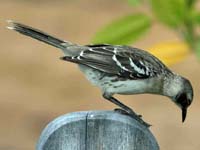
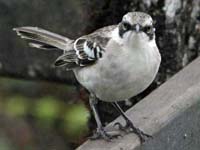
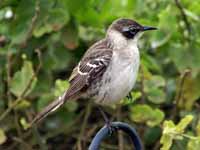
Mockingbird, Espanola mockingbird Mimus macdonaldi
Description: The Espanola mockingbird, also known as the Hood mockingbird, has brownish grey plumage, a bold dark mask, and dark malar stripes. The underparts are pale grey with brown mottling. This is the largest of the mockingbirds of the Galapagos islands and it also has the largest and most curved bill. They are very bold, landing on hats and backpacks looking for food. It does not mimic other species. The nest is placed in a cactus. The Espanola mockingbird is 26 to 27 cm long. The similar Galagos mockingbird has a shorter and straighter bill and its underparts are much whiter.
Range: Espanola Island, Galapagos.
Habitat: Throughout the dry scrub of the island.
Diet: Mainly a predator and scavenger. Also fruits, seed, arthropods.
Conservation status: It is listed as Near Threatened as the population is small but stable.
Image by: 1) Tim Ellis 2, 3) Benjamint444Range: Espanola Island, Galapagos.
Habitat: Throughout the dry scrub of the island.
Diet: Mainly a predator and scavenger. Also fruits, seed, arthropods.
Conservation status: It is listed as Near Threatened as the population is small but stable.



Mockingbird,_ San_Cristobal Mimus melanotis
Description: The San Cristobal mockingbird has greyish-brown upperparts and crown with some darker streaks. The wings and tail are dark brown. It has a white supercilium, black eye patch, and black lores. The underparts are whitish with some brown markings on the breast and flanks. The San Cristobal mockingbird is 25 to 26 cm long. It is not reported to mimic other bird species vocals. The nest is placed in a tree.
Range: San Cristobal of the Galapagos. It is the only mockingbird species on the island.
Habitat: Most areas of the island except dense forests, wetlands, and grasslands.
Diet: Insects and other arthropods that it finds on the ground. Also lowhanging fruits and berries.
Conservation status: It is listed as Near Threatened as the population is small but stable.
Image by: 1) Benjamint444 2) BRJ_IncRange: San Cristobal of the Galapagos. It is the only mockingbird species on the island.
Habitat: Most areas of the island except dense forests, wetlands, and grasslands.
Diet: Insects and other arthropods that it finds on the ground. Also lowhanging fruits and berries.
Conservation status: It is listed as Near Threatened as the population is small but stable.
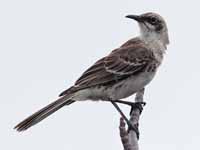
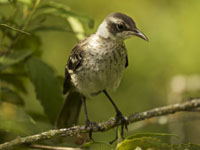
Genus Oreoscoptes - 1 species
Thrasher,_Sage Oreoscoptes montanus
Description: The sage thrasher has grey-brown upperparts, off-white underparts with dark streaks, a straight relatively short bill, yellow eyes, and a long tail. The sage thrasher is 20 to 23 cm long. It often sings for a long time; most of the song being its own, but it also mimics other species. The nest is usually placed in sagebrush.
Range: Western US from almost the Canadian bordered south into Mexico.
Habitat: Mainly areas of sagebrush; also shrubby areas.
Diet: Insects which they find on the ground; also fruits.
Conservation status: Least Concern.
Image by: 1) ADJ82 - California 2) Alan D Wilson - New Mexico 3) Peter Massas - New Jersey 4) Wolfgang Wander - Wyoming Range: Western US from almost the Canadian bordered south into Mexico.
Habitat: Mainly areas of sagebrush; also shrubby areas.
Diet: Insects which they find on the ground; also fruits.
Conservation status: Least Concern.
4) Worn adult
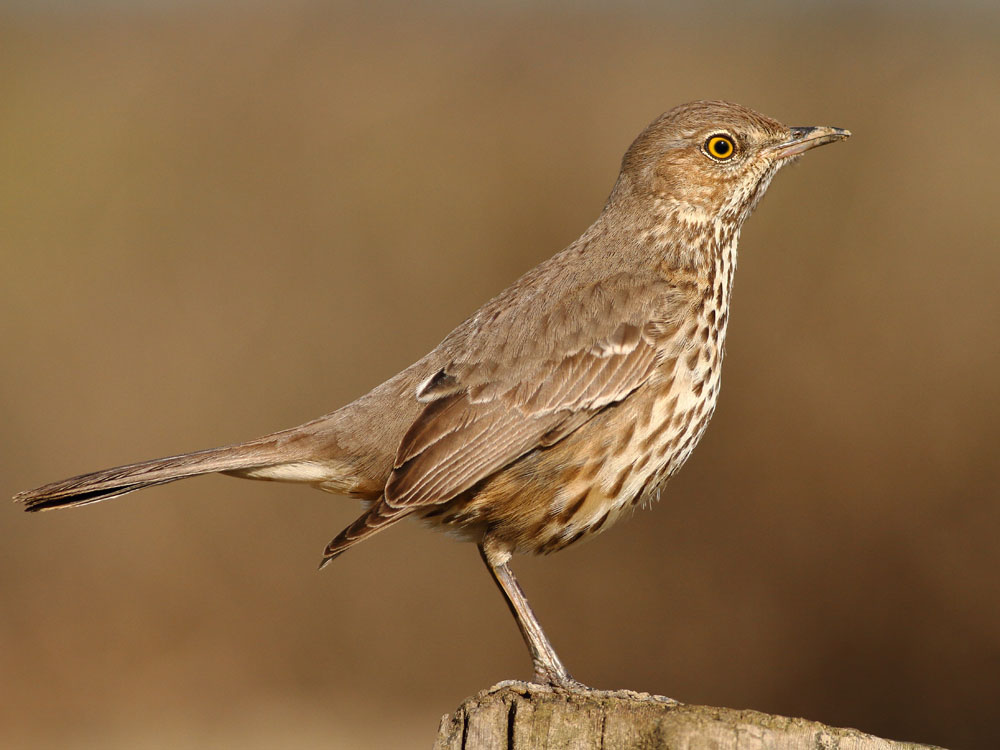
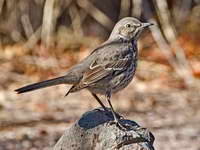
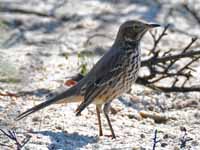

Genus Ramphocinclus - 1 species
Thrasher,_White-breasted Ramphocinclus brachyurus
Description: The white-breasted thrasher has dark brown upperparts. The throat and most of the undrparts are white. It has brown flanks and a brown lower-belly. The eyes are red and the bill is black. The white-breasted thrasher is 23 to 25 cm long. They are vocal, especially when threatened, but not very musical; not known to mimic other bird species. The nest is placed in a small tree or bush, but also occasionally on leaves.
Range: Martinique and Saint Lucia (Lesser Antilles).
Habitat: Deciduous woodlands with lots of leaf litter.
Diet: Insects and other arthropods, fruits, small vertebrates. They forage on the ground amongst the leaf litter.
Conservation status: It is listed as Endangered because of its restricted range.
Image by: 1)Adrien_Chateignier 2) Aaron_MichaelRange: Martinique and Saint Lucia (Lesser Antilles).
Habitat: Deciduous woodlands with lots of leaf litter.
Diet: Insects and other arthropods, fruits, small vertebrates. They forage on the ground amongst the leaf litter.
Conservation status: It is listed as Endangered because of its restricted range.
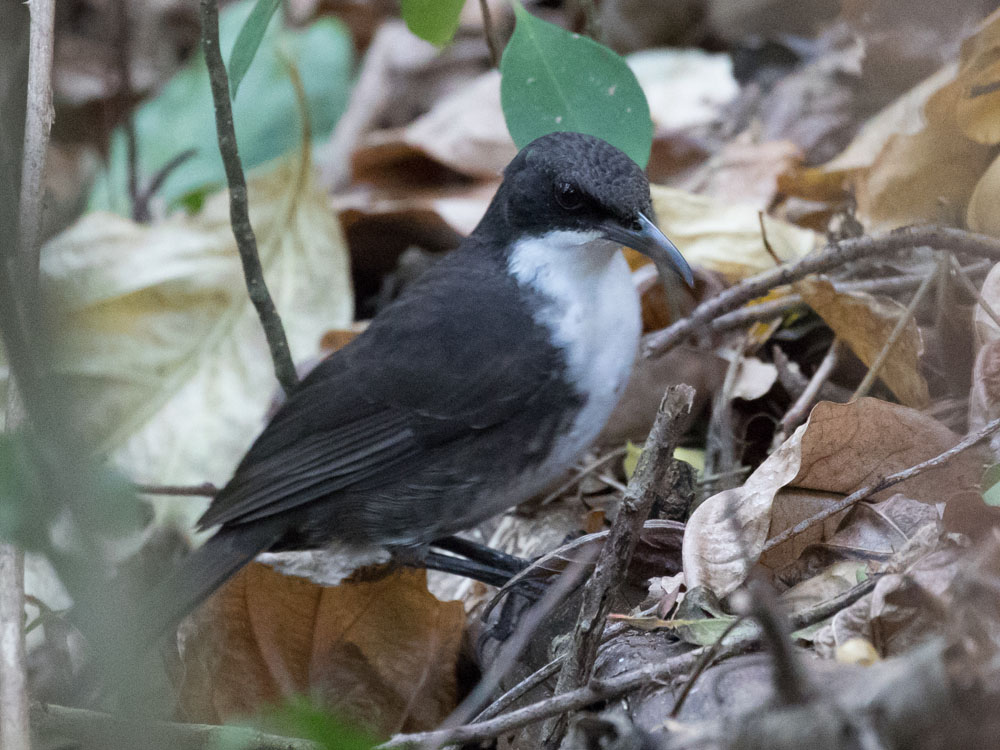
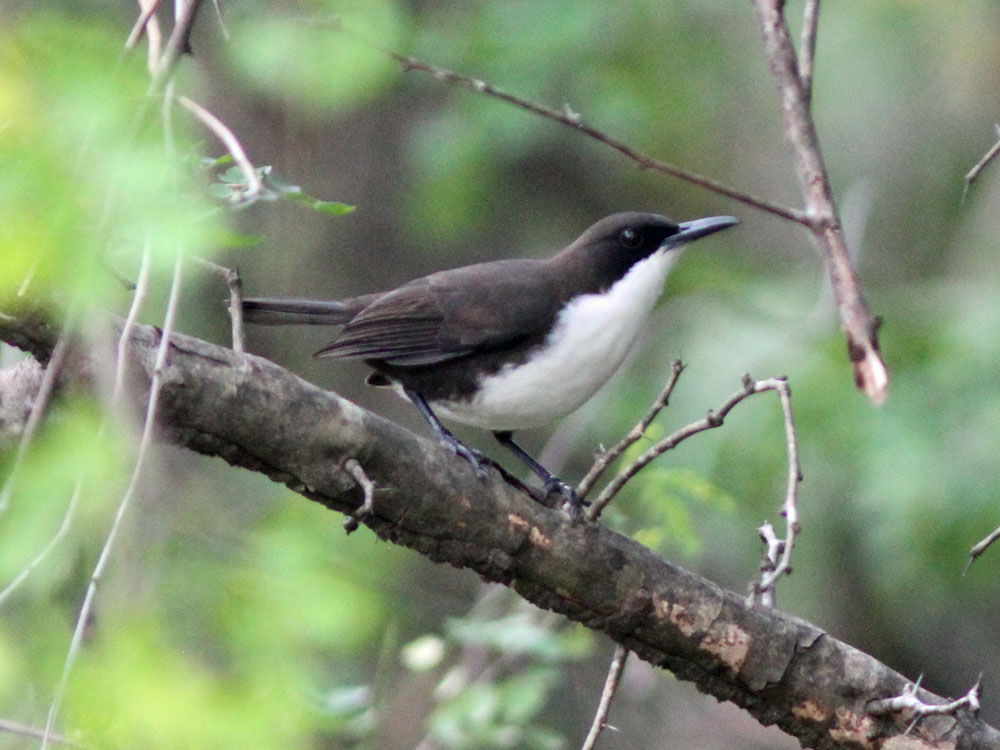
Genus Toxostoma
Most thrashers feed on ground dwelling insects. They rarely fly in the open, preferring to keep hidden in brush. They don't fly much thus their wings are short and rounded. Their songs are prolonged outpouring of warbled phrases that can be repeated two or several times and can be heard from considerable distances,
Thrasher,_Bendire's Toxostoma bendirei
Description: The Bendire's thrasher has grey upperparts including the head, but with a darker tail. The underparts are pale grey with darker triangular marks. It has yellow eyes and a down-curved dark-grey bill. The Bendire's thrasher is about 24 cm long. It sings its song for a considerable period of time and them goes quiet for a while; it is not known to mimic other bird species. Their nest is placed in brush, trees, or cactus. The similar curve-billed thrasher a longer and more curved bill.
Range: Southwest North America and northern Mexico, mainly along the southern border that Arizona and New Mexico shares with Mexico.
Habitat: Brush-filled deserts and valleys and drylands.
Diet: Forages on the ground mainly for insects. Also eats fruit.
Conservation status: It is listed as Vulnerable because of conversion of part of its range to agriculture
Image by: 1) Charlie Westerinen - near Aguila, Arizona 2, 3) Jerry Oldenettel - California Range: Southwest North America and northern Mexico, mainly along the southern border that Arizona and New Mexico shares with Mexico.
Habitat: Brush-filled deserts and valleys and drylands.
Diet: Forages on the ground mainly for insects. Also eats fruit.
Conservation status: It is listed as Vulnerable because of conversion of part of its range to agriculture


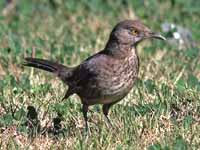
Thrasher,_Brown Toxostoma rufum
Description: The Brown thrasher has reddish- brown upperparts including the tail. There are two thin white wingbars. It has a, black malar stripe, white throat, yellow eyes, and a dark down-turned bill. The white underparts have dark streaks. It is the only thrasher east of the rockies. It has a repertoire of over 1000 songs, perhaps the largest of any species. Those songs appear to be mostly its own, mimicing other species only occasionally. It is similar to the long-billed thrasher which does not have a reddish tint to the upperparts and has heavier streaks to its underparts.
Range: East of the Rockies for southern Canada the USA.
Habitat: Woodland edges, thickets, dense brush.
Diet: Insects, earth worms, snails, fruits, berries, seeds, nuts.
Conservation status: Least Concern.
Image by: 1, 2) Dick Daniels - North Carolina 3) Charlie_Westerinen - Virginia 4) Mykola_Swarnyk - TorontoRange: East of the Rockies for southern Canada the USA.
Habitat: Woodland edges, thickets, dense brush.
Diet: Insects, earth worms, snails, fruits, berries, seeds, nuts.
Conservation status: Least Concern.
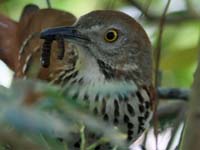
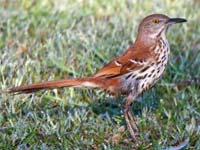
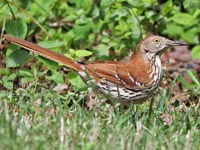
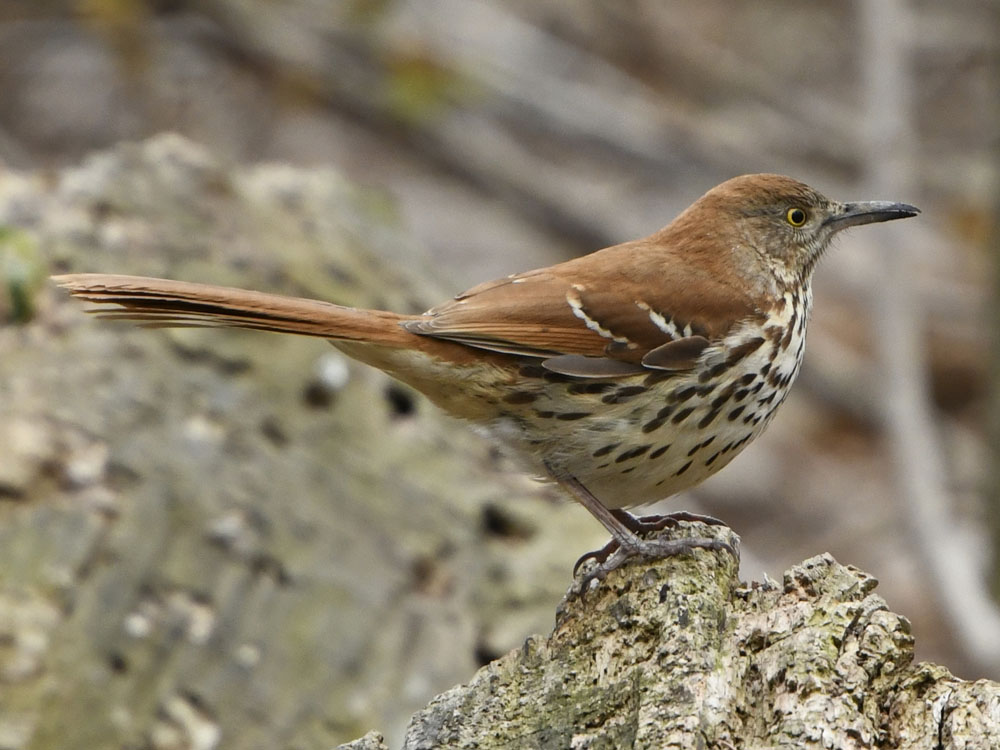
Thrasher,_California Toxostoma redivivum
Description: The California thrasher has greyish-brown upperparts with olive-brown on the tail. There is a light supercilium and the face has squiggly patterns made of curvy light and dark streaks. The eyes are dark (unlike most thrashers) and there is a faint but dark eye-line. It has a very long curved bill. It has buffy underparts and under-tail. At 32 cm long, the California thrasher is the largest thrasher. It has pleasing songs of its own plus is a very good mimic of other bird species. The nest site is a bush. The similar crissal thrasher has lighter eye and no eye-line while the California thrasher has a dark eye-line.
Range: California and Baja California.
Habitat: Dry scrublands (chaparral). juniper brushlands, woodlands with dense understory.
Diet: Insects and other arthropods during breeding season. Also fruits. It forages on the ground, usually walking rather than flying to the next foraging site.
Conservation status: Least Concern.
Image by: 1) Alan Vernon 2) Linda Tanner 3) Len Blumin in San Benito County, California Range: California and Baja California.
Habitat: Dry scrublands (chaparral). juniper brushlands, woodlands with dense understory.
Diet: Insects and other arthropods during breeding season. Also fruits. It forages on the ground, usually walking rather than flying to the next foraging site.
Conservation status: Least Concern.

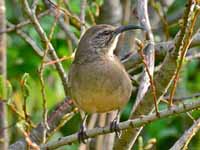
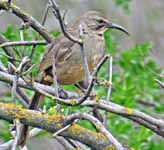
Thrasher,_Cozumel Toxostoma guttatum
Description: The Cozumel thrasher has brown upperparts, grey-brown lores, grey-brown ear coverts, and buffy-white underparts with black teardrop shaped spots.
Range: Island of Cozumel off Mexico mainland.
Habitat: Scrubland.
Diet: Probably insects and fruits.
Conservation status: Not seen in more than 10 years and may be extinct.
Range: Island of Cozumel off Mexico mainland.
Habitat: Scrubland.
Diet: Probably insects and fruits.
Conservation status: Not seen in more than 10 years and may be extinct.
Thrasher,_Crissal Toxostoma crissale
Description: The crissal thrasher has mainly brownish-grey plumage. Its name comes from the lower belly and crissum area which are an attention getting bright chestnut. The bill is long and curved, It has a white throat which is bordered by black malar stripes and an adjacent white stripe. They rarely fly, preferring to run for cover when disturbed. The crissal thrasher is large for a thrasher, about 30 cm long. about half of which is due to its long tail. Unlike the California thrasher, it does not have a dark eye-line. And unlike the Le Conte's thrasher, crissal thrashers are secretive and like brushy areas. The crissal thrasher has a sweeter song than the California thrasher and is not thought to mimic other species songs. The nest site is a tree or thicket.
Range: Southwest North America.
Habitat: Bushy areas with considerable cover.
Diet: Mainly insects, also other arthropods, fruits, seeds.
Conservation status: Least Concern.
Image by: 1) John J. Mosesso 2) Jerry Oldenettel - New Mexico 3) J N Stuart - Nevada 4) Steven_Severinghaus - NevadaRange: Southwest North America.
Habitat: Bushy areas with considerable cover.
Diet: Mainly insects, also other arthropods, fruits, seeds.
Conservation status: Least Concern.
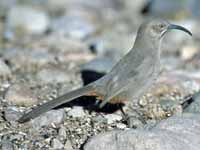
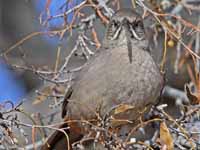
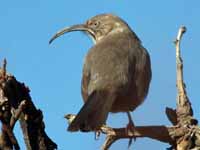
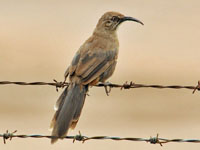
Thrasher,_Curve-billed Toxostoma curvirostre
Description: The curve-billed thrasher has grey upperparts, paler underparts, a down-curved bill, and birght yellow eyes. It has faint spots on the breast. Other thrashers have bills that are more curved, but they were not known when the curve-billed thrasher was named. The curve-billed thrasher is up to 28 cm long. It has a good size repertoire of its own songs, and mimics occasionally. The nest is placed in a bush, cactus, or small tree. The similar Bendire's thrasher has triangular spots on its breast.
Range: Arizona, Colorado, New Mexico, Texas, Mexico.
Habitat: Mainly desert areas; also near civilization.
Diet: Insects and other arthropod which if finds on the ground. Will climb for berries.
Conservation status: Least Concern.
Image by: 1) Alan D Wilson - New Mexico 2) Alan Vernon - Arizona 3) Jerry Oldenettel - New Mexico 4) Dick - Desert Botantical Gardens in Pheonix , ArizonaRange: Arizona, Colorado, New Mexico, Texas, Mexico.
Habitat: Mainly desert areas; also near civilization.
Diet: Insects and other arthropod which if finds on the ground. Will climb for berries.
Conservation status: Least Concern.
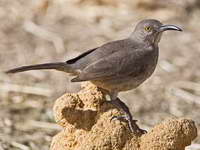

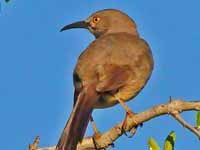
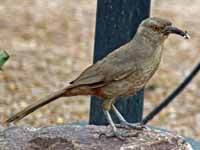
Thrasher,_Grey Toxostoma cinereum
Description: The grey thrasher has grey-brown upperparts, white underparts with arrow-shaped black spots, and yellow eyes. It has a typical curved thrasher's bill, just a little smaller than average. The grey thrasher is about 23 cm long. It has a scratchy warbling song, often repeated two to three times. Not known for mimicking. Their nest is placed in a cactus, brush, or small tree.
Range: Baja California peninsula in Mexico.
Habitat: It lives in desert scrubland with cacti, scattered brushes, and trees.
Diet: Arthropods which it captures on the gound; also cactus fruit.
Conservation status: Least Concern.
Image by: 1) Ron Knight 2) Blake_Matheson 3) Dick_Culbert 4) Tom_BensonRange: Baja California peninsula in Mexico.
Habitat: It lives in desert scrubland with cacti, scattered brushes, and trees.
Diet: Arthropods which it captures on the gound; also cactus fruit.
Conservation status: Least Concern.
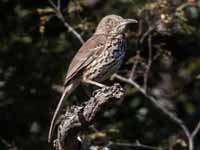
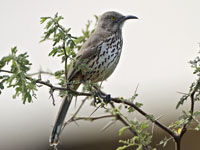
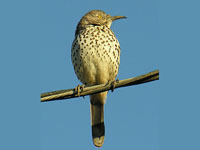
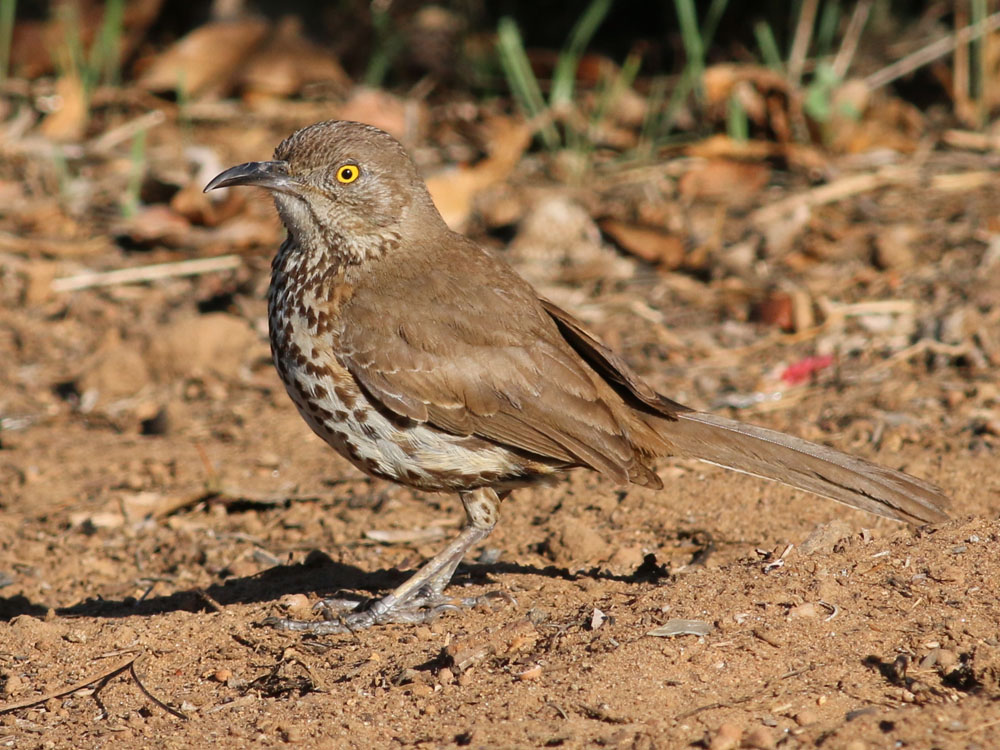
Thrasher,_ Le_Conte's Toxostoma lecontei
Description: The Le Conte's thrasher has pale sandy-grey upperparts, grey-brown ears, a pale whitish throat, and paler grey underparts. It has black sickle-shaped bill and chestnut-brown eyes It is yellowish-brown under the tail. Le Conte's thrasher is the palest of all thrashers. It may sing for 10 to 20 minutes and then take a prolonged break. It varies the song, repeating phrases often two times, infrequenlty three. Not noted for being a mimic. The nest is placed in a scrub or small tree.
Range: Southwest USA, northwest Mexico.
Habitat: Open desert areas; not secretive like most thrashers.
Diet: Arthropodes such as beetles, spiders, caterpillars. Also bird eggs, seeds, berries.
Conservation status: Least Concern.
Image by: 1, 2) Bill Bouton - California 3) Tony_Morris - California 4) Alan_Schmierer - CaliforniaRange: Southwest USA, northwest Mexico.
Habitat: Open desert areas; not secretive like most thrashers.
Diet: Arthropodes such as beetles, spiders, caterpillars. Also bird eggs, seeds, berries.
Conservation status: Least Concern.
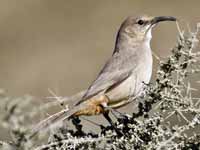


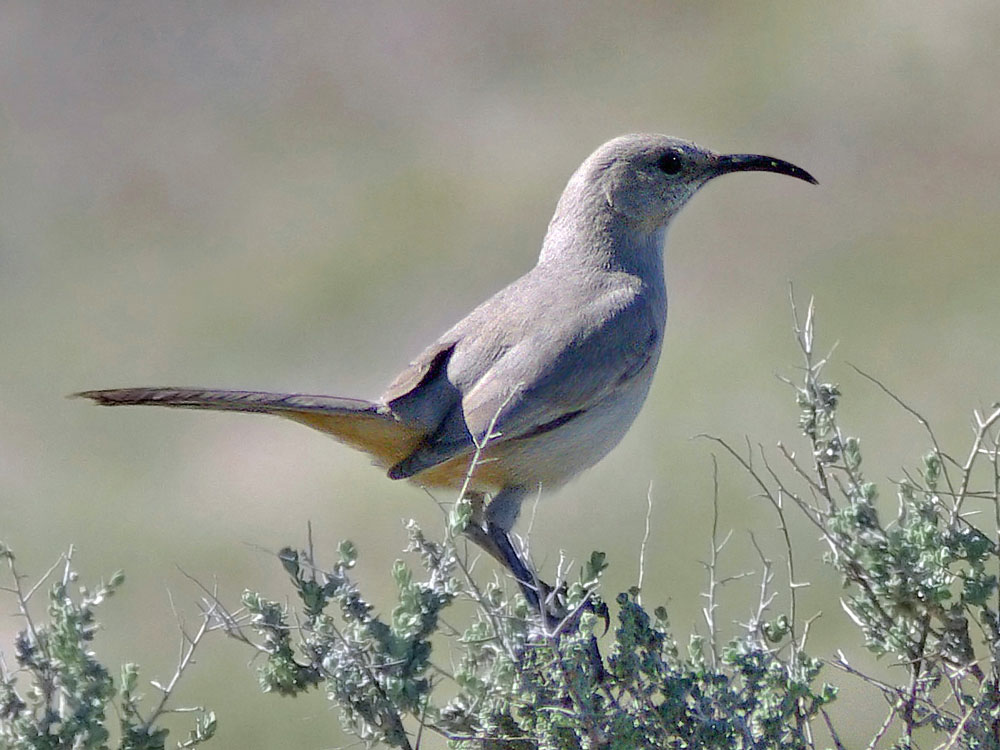
Thrasher,_Long-billed Toxostoma longirostre
Description: The long-billed thrasher has reddish-brown upperparts and a greyish-brown crown. It has whitish underparts with dark streaks formed from oval shapes. It has a long dark brown bill and yellow eyes. The long-billed thrasher is 26 to 29 cm long. It sings most often during breeding season; not known to mimic other species. The nest is placed in a thicket. The similar brown thrasher has lighter streaks on its underparts.
Range: Texas, Mexico.
Habitat: Arid thickets and bushes.
Diet: Insects which it gets on the ground and berries in shrubs and trees.
Conservation status: Least Concern.
Image by: 1) Mark Watson - Texas 2) Alan Wilson 3) Andy_Morffew - Texas 4) Kati_Fleming Range: Texas, Mexico.
Habitat: Arid thickets and bushes.
Diet: Insects which it gets on the ground and berries in shrubs and trees.
Conservation status: Least Concern.
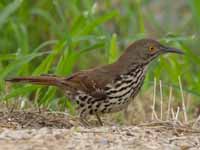
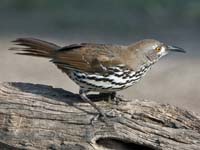
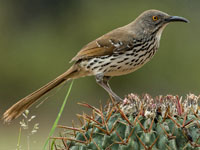
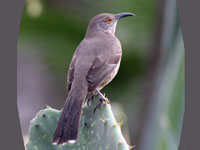
Thrasher,_Ocellated Toxostoma ocellatum
Description: The ocellated thrasher has dark brown upperparts, a faint supercilium, white throat, whitish underparts with black spots. It is not known to be a mimic. The nest site is usually in a thicket. The ocellated thrasher is about 26 cm long.
Range: South-central Mexico.
Habitat: Pine-oak woodlands with brush underneath.
Diet: Arthropods and probably fruits.
Conservation status: Least Concern.
Image by: 1) Amy McAndrews 2) Dominic Sherony 3) Francesco_Veronesi - MexicoRange: South-central Mexico.
Habitat: Pine-oak woodlands with brush underneath.
Diet: Arthropods and probably fruits.
Conservation status: Least Concern.
